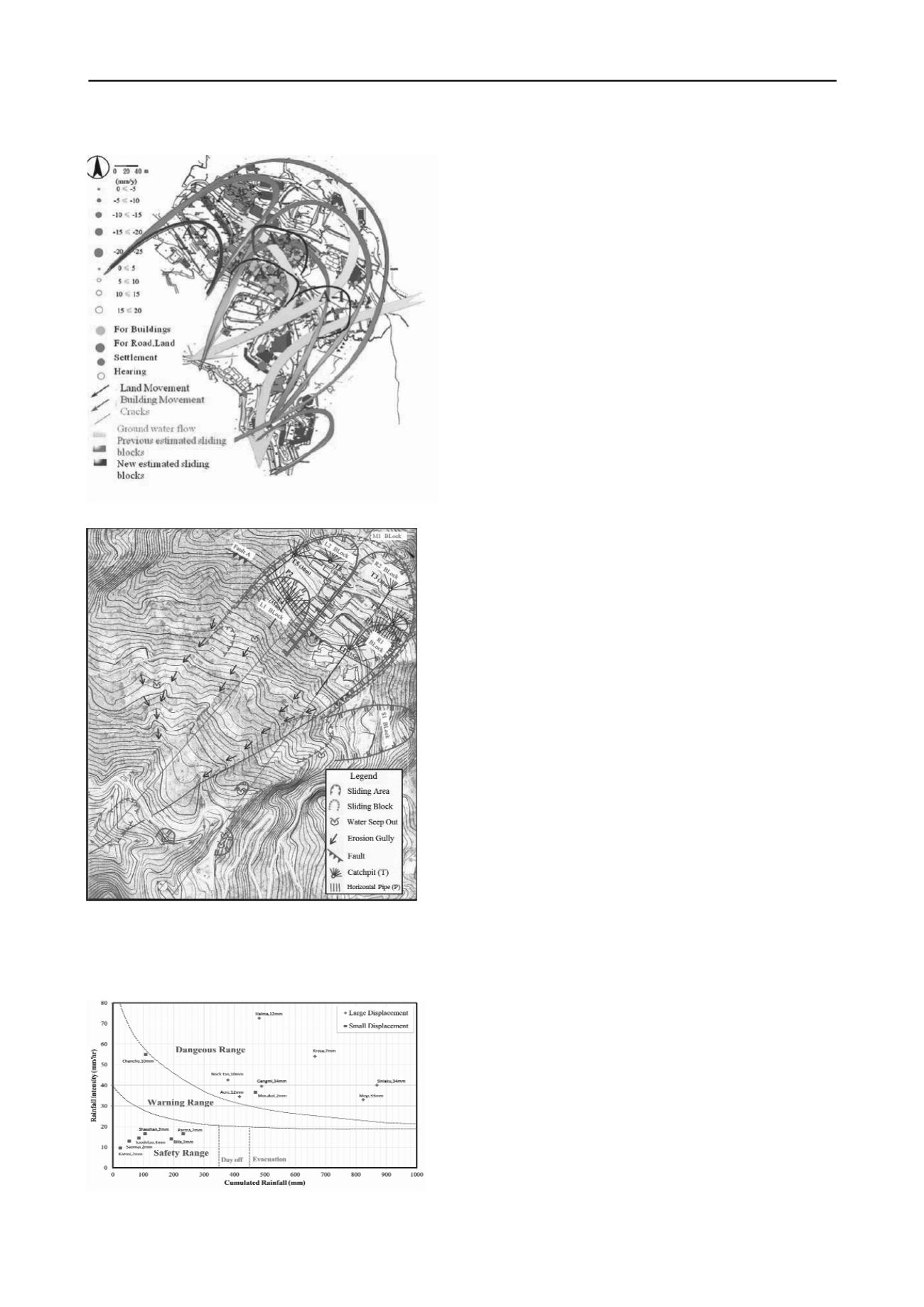
2192
Proceedings of the 18
th
International Conference on Soil Mechanics and Geotechnical Engineering, Paris 2013
and rainfall threshold values were established. Based on the
results, the following conclusions can be made:
Fig. 6 Sliding blocks and movement distribution plane
1. The areas with the most significant settlement and
displacement are located around the buildings of Hui-tsui,
Zhian and Wu-Ming Building. Due to lack of slope stability,
surface cracks appeared and several sliding surfaces have
been observed.
2. The deformation of the top of the inclinometer pipes is
consistent with the displacement monitoring marks.
Findings indicate the primary slope deformation to be
toward the southwest and south direction. In addition,
rainfall was found to be the most significant factor for slope
deformation and slope stability.
3. The results of the slope stability analysis show that an
increase in ground water level is the most critical factor for
slope stability.
4. The distribution of potential sliding blocks was examined by
using slope displacement and settlement data, and the
location of surface cracks. The sliding direction is strongly
correlated to the direction of ground water flow. Depth or
thickness of fill also contributes to slope sliding.
5. Several stabilization measures including catchpits with
horizontal drainage pipes, bore piles and tieback ground
anchors, and threshold value of rainfall are recommended to
improve the slope stability. It was believed that the
information presented is very important for slope disaster
prevention.
9 REFERENCES
Dai F.C. & Lee C.F. 2002. Landslides on natural terrain
—
physical characteristics
and susceptibility mapping in Hong Kong.
Mountain Research and
Development
, 22(1), 40-46.
Hu I-Chou and Liao H. J. 2010. A Model of Slope Mitigation Priority for Alishan
Mountain Road in Taiwan.
Journal of Performance for Constructed
Facilities
,
ASCE
, 24(4), 373-381.
Jeng C.J. 2003. Study on Slope Stability Mechanism of Huafan University by
Using of Inclinometer Displacement and Limiting Equilibrium Stability
Analysis.
Hua Fan Annual Journal
. 9, 115-127.
Jeng C.J. Chu B.L. Tsao S.P. Lin T.A. 2007. Matrix Suction of Unsaturated
Colluvium Slope Influenced by Rainfall and Plant Condition
:
A case of
Taiwan Huafan University.
Wuhan University Journal of Natural Sciences
,
12(4), 689-694.
Jeng C.J. Su D.Z. 2008. Case study on the settlement and displacement monitoring
results on a slope induced by natural hazards.
Proceedings of 3rd Taiwan-
Japan Joint Workshop on Geotechnical Hazards from Large Earthquakes
and Heavy Rainfall
. 119-130.
Jeng C.J. Li C.T. 2009. Case Study on the Numerical Analysis of the Building
Foundation Excavation on the Dip-Slope.
Journal of Architecture
, (68), 147-
162.
Jeng C.J. Hsieh T.Y. 2010. Case study on the sliding surface judgment for the
monitoring slope.
Journal of Huafan art and design
. 6, 1-14.
Fig. 7 Plan for catchpits location
8 CONCLUSIONS AND DISSCUSSION
This paper discusses the displacement and settlement of the
slope, evaluates the sliding block theory, and analyzes slope
stability. After summarizing the results, stabilization measures
Jeng C.J. and Lin T.A. 2011. A Case Study on the In-situ Matrix Suction
Monitoring and Undistubed-sample Laboratory Test for the
Unsaturated
Colluvium Slope.
Soils and Foundations
. 51(2),321-331.
Wang H.M. and Yeh T.C. 2011. An Analysis on the Characteristics of
Extreme Hourly Rainfall of Typhoon over Taiwan.
Meteorological
Bulletin
, 48( 3) September, 1-14.
Fig. 8 Threshold value curves correlate with displacement


